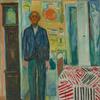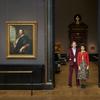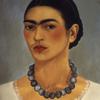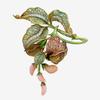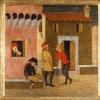Robert Motherwell: Works on Paper
- LONDON, United Kingdom
- /
- August 29, 2011
Robert Motherwell: Works on Paper, the first ever exhibition dedicated to drawings and paintings on paper by Robert Motherwell (1915-1991) to be held in Britain, will be staged at the Bernard Jacobson Gallery, 6 Cork Street, London W1, from 10 October to 26 November 2011. The exhibition, taking place twenty years after the artist’s death, will comprise some ninety works spanning most of his career, with prices ranging from $10,000 to $300,000.
Robert Motherwell was a major figure in the birth and development of Abstract Expressionism and the youngest member of the ‘New York School’, a term he coined. His career spanned five decades during which time he created some of the most iconic images of the 20th century. A passionate advocate and articulate spokesman for Abstract Expressionism, he believed that ideas and emotions were best communicated through the bold forms and gestural lines of abstract art. This exhibition will include sixty works from the Lyric Suite, a group of works from the Beside the Sea series and a selection of works based upon James Joyce’s Ulysses as well as an abstract portrait of the poet. A further selection of works from the 1940s to the 1980s includes Elegy and Je t’aime as well as automatism drawings, work from the Drunk with Turpentine, Gesture and the Open series.
Motherwell came from a educated middle-class family and studied literature, psychology and philosophy at Stanford University, California, and philosophy at Harvard. He decided to become an artist after seeing modern French painting on a year-long trip to Europe in 1938-9 but first, to please his father, he studied art history at Columbia University, New York. There, through his tutor Meyer Shapiro, he met the Chilean-born painter Roberto Matta and other Surrealist artists exiled from Europe whose use of ‘automatism’ had a lasting effect on him as well as on other American artists including Jackson Pollock. Motherwell became very close to Pollock and to Mark Rothko, the other two outstanding figures of Abstract Expressionism.
In 1941 Motherwell went to Mexico with Matta and on the boat he met Maria Emilia Ferreira y Moyers, a Mexican actress, who became his first wife. In Mexico, under the influence of Matta and Wolfgang Paalen, Motherwell worked on his Mexican Sketchbook. Using a technique called psychic automatism, he produced images that were a Surrealist mix of the abstract and the semi-representational. This sketchbook and the trip to Mexico led to his first important paintings, works such as Little Spanish Prison, 1941, now in the collection of the Museum of Modern Art.
Motherwell’s first one-man show at Peggy Guggenheim’s Art of This Century Gallery in New York in 1944 included paintings, drawings and collages all with a Spanish or Mexican theme. The Spanish Civil War became a great moral issue that drove his work for some years and for many his defining image is the 140 monumental works entitled Elegy to the Spanish Republic which began with a small ink drawing illustrating a poem by Harold Rosenberg in 1948. He described these works as “a funeral for something one cared about” and continued to paint them up to his death.
In the late 1940s and the 1950s Motherwell spent some time teaching and lecturing, first at Black Mountain College, North Carolina, where he taught and influenced Robert Rauschenberg and Cy Twombly who died recently, and later at Hunter College, New York. In 1944 he initiated the Documents of Modern Art series translating and publishing for the first time many of the important documents of the European avant-garde.
From 1954 to 1958, during the break-up of his second marriage, he worked on a small series of paintings which incorporated the words Je t’aime, expressing his most intimate and private feelings. His collages began to incorporate material from his studio such as cigarette packets and labels becoming records of his daily life. He was married for the third time, from 1958 to 1971, to Helen Frankenthaler, a successful abstract painter. In 1962 they spent the summer at the artists’ colony at Provincetown, Massachusetts, where the coastline inspired the Beside the Sea series of 64 paintings, the oil paint splashed with full force against rag paper imitating the sea crashing on the shore in front of his studio.
The Lyric Suite, named after Alban Berg’s string quartet, dates from 1965 when, as Motherwell recalled, “I went to a Japanese store to buy a toy for a friend’s kid, and I saw this beautiful Japanese paper and I bought a thousand sheets. And made up my mind, this was in the beginning of April 1965, that I would do the thousand sheets without correction. I’d make an absolute rule for myself. And I got to 600 in April and May, when one night my wife and I were having dinner and the telephone rang. And it was Kenneth Noland in Vermont saying that I should come immediately. And I said, ‘what’s happened?’ And he said, ‘David Smith’s been in an accident’.” Smith, the sculptor, was Motherwell and Frankenthaler’s great friend. Jumping into their Mercedes they sped to Vermont but arrived 15 minutes after Smith had died. Motherwell stopped work on the series. He said of them: “And then one year I had them all framed, and I like them very much now. I should also say that I half painted them and they half painted themselves. I’d never used rice paper before except occasionally as an element in a collage. And most of these were made with very small, I mean very thin lines. And then I would look at amazement on the floor after I’d finished. It would spread like spots of oil and fill all kinds of strange dimensions.”
From 1967 to the end of the ‘80s, he worked on another major series with the general title Open, his response to the work of the younger Minimalists. Robert Motherwell died in his Provincetown home in 1991 after a prolific and highly successful career. Robert Hughes, the distinguished art critic for Time magazine, one of Motherwell’s greatest advocates, wrote of a retrospective exhibition in Buffalo in 1988: “…his full maturity came after the abstract expressionist ‘period’ – in fact, after 1960 – and his career illustrates the perils of generalising about decades, groups or movements. Of course there are expressionist elements in Motherwell, and strong ones at that. But the rhythm of this show obliges one to discard the hearty cliché of the abstract expressionist as a kind of existential romantic, flinging pots of paint in the eyes of fate.”
In 1981 Motherwell founded the Dedalus Foundation in order to foster public understanding of modern art and modernism through its support of research, education, publications and exhibitions. The Foundation also owns the copyright of Motherwell’s work and his archive and is sponsoring the catalogue raisonné of his paintings, collages and paintings on paper to be published by Yale University Press in the autumn of 2012. A catalogue raisonné of his prints was sponsored by the Foundation and published by the Walker Art Center in 2003.
Bernard Jacobson Gallery held the first exhibition in Britain of Robert Motherwell’s Open series in 2008, and in 2013 the gallery will hold an exhibition of the collages. In 2015, to coincide with Motherwell’s centenary of this birth, they will have a major exhibition of paintings.
Robert Motherwell: Works on Paper coincides with a major exhibition, Painting on Paper: The Drawings of Robert Motherwell taking place at the Art Gallery of Ontario, Toronto, from 25 June to 11 December 2011, but the 55 works on view in Canada are of course not for sale unlike the works to be found at the Bernard Jacobson Gallery in London.

